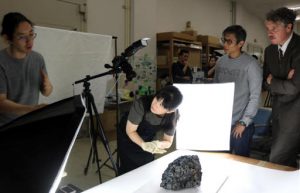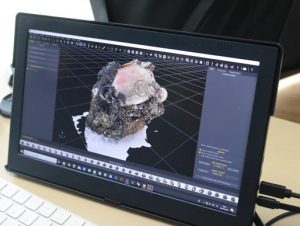American artist and colleagues create 3D images of A-bombed artifacts for “ZERO Project Hiroshima” event
Oct. 21, 2019
by Miho Kuwajima, Staff Writer
American artist Cannon Hersey, along with other artists, are creating cutting-edge 3D images of A-bombed artifacts by taking photographs of these items from numerous angles. The artifacts are held at the Hiroshima Peace Memorial Museum in Naka Ward. Some of the images they have completed will be shared at a peace event called “ZERO Project Hiroshima,” which is being spearheaded by Mr. Hersey at the former Hiroshima Branch of the Bank of Japan from October 22 to November 2.
Mr. Hersey’s team took photos of ten A-bombed items – among them a chunk of bottle caps, a cosmetics bottle, and a rice bowl that was melted and deformed by the bomb’s heat – in the museum’s storage room. Kosuke Nagata, 29, an artist based in Yokohama, asked the museum curator to move each artifact by small degrees as he shot them frame by frame, taking about 60 to 80 pictures of each item with his digital camera.
The photo data was then edited with software designed to synthesize the photographs and create images with stereoscopic effects. Mr. Nagata said, “I hope viewers will be able to perceive fine details in these images, like the air bubbles that formed around an object when it was melted by the bomb’s heat rays.” Their 3D images will also be shown in New York during the period when the Review Conference for the Treaty on the Non-Proliferation of Nuclear Weapons (NPT) takes place in that city in April and May of next year.
Mr. Hersey said with enthusiasm, “The image enables you to see something hyper real because of the high resolution. It gives us the opportunity to learn about something that’s very old in a new way, a way in which young people and everyone else can feel closer to the objects. And we chose these objects because they’re things that anyone can relate to, like [omission] a teapot, a pen, and some coins. All cultures have these things so people can think of their own lives and relate to the A-bombed artifacts more easily. Hiroshima’s experience isn’t so easy for people to relate to because it seems so long ago and far away.”
Shuichi Kato, the deputy director of the museum, said, “We’ll take into account people’s reactions to these 3D images and consider how we might make use of them at the museum.”
(Originally published on October 21, 2019)
Here is the moving image.
American artist Cannon Hersey, along with other artists, are creating cutting-edge 3D images of A-bombed artifacts by taking photographs of these items from numerous angles. The artifacts are held at the Hiroshima Peace Memorial Museum in Naka Ward. Some of the images they have completed will be shared at a peace event called “ZERO Project Hiroshima,” which is being spearheaded by Mr. Hersey at the former Hiroshima Branch of the Bank of Japan from October 22 to November 2.
Mr. Hersey’s team took photos of ten A-bombed items – among them a chunk of bottle caps, a cosmetics bottle, and a rice bowl that was melted and deformed by the bomb’s heat – in the museum’s storage room. Kosuke Nagata, 29, an artist based in Yokohama, asked the museum curator to move each artifact by small degrees as he shot them frame by frame, taking about 60 to 80 pictures of each item with his digital camera.
The photo data was then edited with software designed to synthesize the photographs and create images with stereoscopic effects. Mr. Nagata said, “I hope viewers will be able to perceive fine details in these images, like the air bubbles that formed around an object when it was melted by the bomb’s heat rays.” Their 3D images will also be shown in New York during the period when the Review Conference for the Treaty on the Non-Proliferation of Nuclear Weapons (NPT) takes place in that city in April and May of next year.
Mr. Hersey said with enthusiasm, “The image enables you to see something hyper real because of the high resolution. It gives us the opportunity to learn about something that’s very old in a new way, a way in which young people and everyone else can feel closer to the objects. And we chose these objects because they’re things that anyone can relate to, like [omission] a teapot, a pen, and some coins. All cultures have these things so people can think of their own lives and relate to the A-bombed artifacts more easily. Hiroshima’s experience isn’t so easy for people to relate to because it seems so long ago and far away.”
Shuichi Kato, the deputy director of the museum, said, “We’ll take into account people’s reactions to these 3D images and consider how we might make use of them at the museum.”
(Originally published on October 21, 2019)
Here is the moving image.









